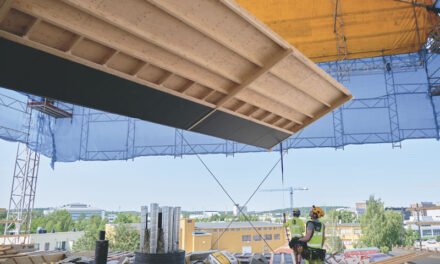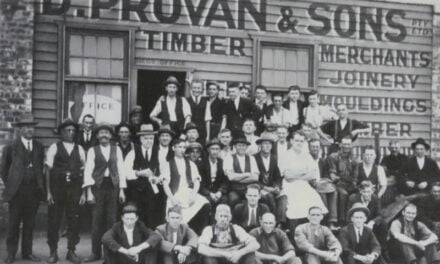Updates to the AS/NZS 1604 series will help with specifying to preservative treatment standards. By Craig Kay, national product engineer, Tilling
The ‘Making it last’ article of the April 2020 edition of TTN was centred on the use of preservative-treated EWP in the external environment. The intent of the article was to reinforce to building professionals and consumers the fact that, provided the preservative-treated EWP was correctly detailed, it would provide the durability expected for timber in that application.
Unfortunately, despite articles like this and other tangible evidence such as written warranties produced by manufacturers against decay for preservative-treated EWP, the SmartFrame Design Centre is now seeing a so-far small but influential number of Building Surveyors making policy decisions not to accept H3-treated LVL in any external application. This issue will need to be addressed by the industry in early 2021 to prevent misinformation spreading. Happily, updates to AS 1604 should provide some additional clarity.
The AS/NZS 1604 series of standards dealing with timber preservation has now become even more relevant within modern timber framing. We now have an almost ubiquitous use of softwood framing and EWP, most of which (there are exceptions) are subject to insect (termites and others) attack, and biological decay if exposed to moisture.
All Australian standards are subject to review at set intervals to ensure that they reflect contemporary industry practice but, unlike many standards that require little change between those review periods, this one is virtually in a constant state of review due to rapidly developing timber preservative technology.
As outlined in my earlier articles about AS 1684, an Australian Standard does not command any regulatory authority on its own and it is only when that standard is referenced by legislation, regulations that accompany legislation, a legally enforceable contract or similar that it gains legal authority. Unlike well-known standards like AS 1684, which are Primary Reference Documents within Schedule 4 of the NCC, the AS/NZS 1604 series is deemed a Secondary Reference Document because it is referenced by AS 3660 Termite Management standards. Thus, a search of the NCC will not see any listing of AS/NZS 1604.
Currently AS/NZS 1604 Specification for preservation treatment standard exists as five parts:
- Part 1– Sawn and round timber (Note, part 1 is an AS standard only, not a joint AS/NZS)
- Part 2 – Reconstituted wood-based products
- Part 3 – Plywood
- Part 4 – Laminated Veneer Lumber (LVL)
- Part 5 – Glued laminated timber products.
The companion standard to the AS/NZS 1604 series is the AS/NZS 1605 series – Methods for sampling and analysing timber preservatives and preservative-treated timber, which provides the standard test methods to calculate the penetration and residual volume of preservative chemical within a test sample. This document is used to provide verification of conformance or otherwise to AS/NZS 1604. This document is primarily used by test laboratories and treatment plants and is not one the average building professional would ever use.
The AS/NZS series standard has now been extensively revised and, when the latest edition is published in early 2021, experienced users of the existing standard will notice some significant changes. There are now only three (3) parts dealing individually with products and treatment, demonstrating compliance and test methods. They are:
- AS/NZS 1604 Preservative-treated wood-based products Part 1: Products and treatment. The former Parts 1-5 of the existing standard have now been amalgamated into one. This change reflects the fact that the timber preservative chemicals are essentially common for all wood-based products, thus it made good sense to amalgamate five different parts outlining similar provisions, into one document.
For all intents and purposes, the retention volumes and penetration requirements for preservative chemicals within the penetration zones of the wood in existing standards that people are used to have remained unchanged, apart from some minor common sense decimal place reductions to match the available accuracy obtainable from test procedures.
This change will have large initial ramifications for the building industry and will require all standard drawings and details that currently reference AS/NZS 1604 parts 2 to 5, to be amended to read AS/NZS 1604:1.
- AS/NZS 1604 Preservative-treated wood-based products Part 2: Verification requirements It was always assumed that the existing standard implied, if not explicitly stated that there needed to be a 100% pass of the retention and penetration requirements listed in Parts 1-5. if we take the example of LVL H2s glueline treated with Bifenthrin, Table H2.2 lists the minimum residual as 0.0021% mass/mass, a very small amount but is higher than the minimum found effective from field trials, to allow for some variability. If one of the test results of a batch gives a result 0.0020% (<0.0021%) under the current standard it technically fails, but realistically it would still be fit for purpose.
Wood is a natural fibre and exhibits variable properties. Readers who are familiar with the structural design of wood will know that the characteristic values are based upon the lower 5th percentile values with a 75% confidence level. Therefore, up to 5% of a sample size of 30 or more may exhibit strengths lower than the stated characteristic value.
This same concept successfully used all around the world for decades for timber strength values has now been introduced into the timber preservation realm in Australia for the first time.
The different statistical systems developed for AS/NZS 1748 Timber—Solid—Stress-graded for structural purposes have been modified to consider preservative retention rather than strength and rigorously analysed on thousands of test results to ensure that each method gives equal reliability of results.
These statistical methods also suit the new paradigm for increasing volumes of timber to be preservative treated as part of the in-line production process and reflect the change in treatment technology. This is a good example of where the standard is modified to keep abreast of contemporary manufacturing methods.
- AS/NZS 1604 Preservative-treated wood-based products Part 3: Test methods The AS/NZS 1605 series Methods for sampling and analysing timber preservatives and preservative-treated timber has been renamed, and will now be Part 3 of the AS/NZS 1604 series, thus keeping all the components of timber preservation under the one standard instead of two different ones.
Preservative-treated timber is protected against the expected biological hazards in the referenced hazard zone. Being preservative treated does not mean that it no longer needs to be correctly detailed; if subject to wetting and drying, it will still surface check and crack.
Timber that is preservative treated in conformance with this standard and correctly detailed has been consistently demonstrated to provide fit for purpose durability, a fact we should be emphasising when talking with designers and builders.
For more information on this topic, contact Craig Kay and the Tilling engineers via email at techsupport@tilling.com.au













